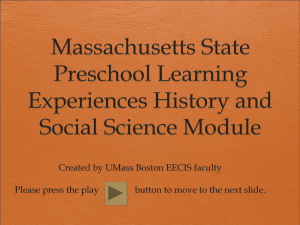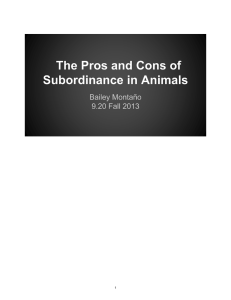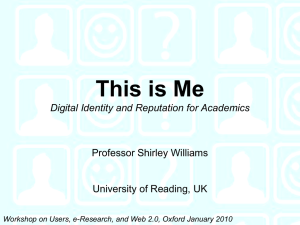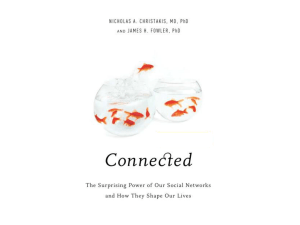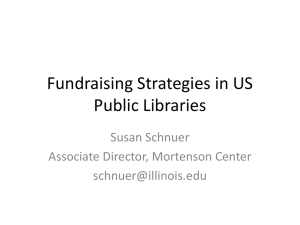Document 15284161
advertisement
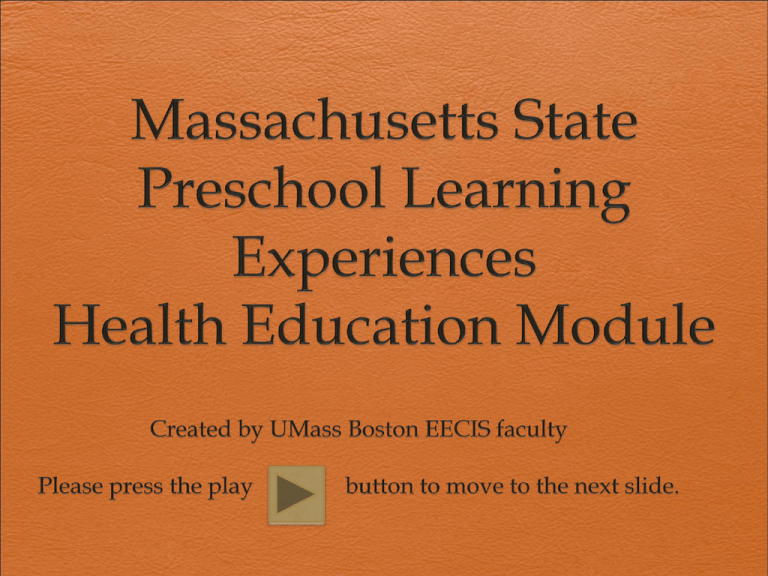
Overarching Principles These principles should be kept in mind at all times when thinking about preschool curriculum and working with young children. 1. All children are capable of learning 2. Children show individual differences in development 3. Knowledge of child growth and development is essential for program development and implementation 4. Children’s language skills are the best indicators of academic success 5. Developmental domains are highly interrelated 6. Young children learn by doing 7. Families are the primary caregivers and educators of their young children Overview of the Health Education Preschool Learning Experiences Physical Development Social and Emotional Health Safety and Health Care Review the Overview of Health Education document before continuing this module. Physical Development 1 1. Listen to and use appropriate language describing the names and functions of parts of the human body. Books about Body Functions Parts and More Parts by Tedd Arnold Me and My Amazing Body by Joan Sweeney The Magic School Bus Inside the Human Body by Joanna Cole Physical Development 2 2. Build body awareness, strength, and coordination through locomotion activities. Gross Motor Activities Gross Motor Activities Hopping on one or two legs Skipping Running Swinging Riding a scooter or tricycle Animal Movement Imitations Image courtesy of Bob Grahame (http://www.flickr.com/photos/83712832@N00/13623 03899/) (2007) Attribution-NonCommercialShareAlike 2.0 Generic (CC BY-NC-SA 2.0) Frog Rabbit Kangaroo elephant Physical Development 3 3. Discuss various aids and accommodations used by people for the activities of daily life. Age Appropriate Books about Children with Disabilities Image courtesy of flickr by y.accesslab http://farm6.static.flickr.c om/5204/5295173306_9 0944a88c7_z.jpg (2009) (CC BY-NC-ND 2.0) Image courtesy of flickr by hm.matheus http://farm2.static.flickr.c om/1126/4609827016_1 bb49bf82c_z.jpg (2009) (CC BY-NC-ND 2.0) Image courtesy of flickr by Clint Gardner http://farm1.static.flickr.c om/172/395945986_b99 33cc3f4_z.jpg?zz=1 (2009) (CC BY-NC-ND 2.0) Physical Development 4 4. Build awareness of directionally and position in space. Image courtesy of wickedlocal.com http://t3.gstatic.com/images?q=tbn:ANd9GcT40lPjSKeLy5 aq9FuLS5FQe8tb_jLGKSX1NyhcuMtCC784oXM&t=1 (2007) CC BY-NC-ND 3.0 Songs and Games for Spatial Awareness Hokey Pokey Simon Says Follow the Leader Jigsaw Puzzles Physical Development 5 5. Use both sides of the body to strengthen bilateral coordination. Image courtesy of flickr by mollyjolly http://farm4.static.flickr.com/3013/2629982264_a338d7a355_z.jpg?zz=1 (2010) CC BY-NC-ND 2.0 Bilateral Activities Pushing a wheelbarrow Jumping with two feet over a rope or jump-roping Lifting things with both arms Pushing a block on the ground with both feet Sack Races Physical Development 6 6. Alternate the left and right sides of the body and cross the midline of the body. Image courtesy of flickr by SewPixie http://farm1.static.flickr.com/248/3263517809_0f1625dc1e_z.jpg?zz=1 (2010) CC BY-NC-ND 2.0 Single Side Activities Hopping on one foot Turning a jump-rope with one hand Carrying an object with one hand Hand over hand progress on climbing bars Moving a large bubble wand with one arm Physical Development 7 7. Build upper body strength and stability to gain controlled movement of shoulders. Shoulder Strengthening Activities Water-Funnel Video Crab walk Propelling self on a scooter with the arms Hanging from two arms on the monkey bars Pushing a wheelbarrow or cart Pouring objects in a sand or water table Physical Development 8 8. Strengthen hand grasp and flexibility. Activities Playing with Playdoh with tools Using clothespins Squeezing squirt bottles or a turkey baster in the water table Using a hand-size holepunch Image courtesy of flickr by mirsasha http://farm3.static.flickr.com/2093/1720514272_f4dcb91467_z.jpg (2010) CC BY-NC-ND 2.0 Physical Development 9 9. Use thumb/forefinger in pincer grip. Activities Pegboard Moving small objects between containers Making pictures with stickers Playing with Legos Using tweezers Image courtesy of Luigi Chelsea (http://commons.wikimedia.org/wiki/File:Chiodini_wiki.jpg) (2007) Creative Commons Attribution-ShareAlike Unpotted 3.0 Physical Development 10 10. Use a variety of tools and materials to build grasp-and-release skill. Scissors Video Image courtesy of Tracy Lee (http://www.flickr.com/photos/tracyleephoto/363501 8827/) (2009) Attribution-NonCommercial-NoDerivs 2.0 Generic (CC BY-NC-ND 2.0) Physical Development 11 11. Build finger dexterity. Activities Flipping coins Putting pegs in LiteBrite© Finger plays Dressing dolls with zippers, snaps, and buttons Image courtesy of flickr by Rob Hayes. http://farm5.static.flickr.com/4099/4849581042_d366eba126_z.jpg (2010) CC BY-NC-ND 2.0 Physical Development 12 12. Use eye-hand coordination, visual perception and tracking, and visual motor skills in play activities. Sewing Cards Video Physical Development 13 13. Discuss nutritious meals and snacks and the difference between junk food and healthy food. Image courtesy of Steve Garfield (http://www.flickr.com/photos/stevegarfield/2504561841/) (2008) Attribution-NonCommercial-ShareAlike 2.0 Generic (CC BY-NC-SA 2.0) Physical Development 14 14. Practice personal hygiene and safety measures. Clean eating surfaces Wash hands Do not share utensils or cups Cough into a tissue or your elbow Use cutting tools safely Washing Hands Video Physical Development 15 15. Discuss gender and growth in age-appropriate ways. Image courtesy of Shavar Cross (http://www.flickr.com/photos/shava r/27886472/) (2005) AttributionNonCommercial-NoDerivs 2.0 Generic (CC BY-NC-ND 2.0) Topics •Baby Animals •Babies •Growth •Differences between boys and girls •Differences between boys/men and girls/women •Constancy of gender Image courtesy of Muhammad Mahdi Karim (http://commons.wikimedia.org/wiki/ File:Kid_girl.jpg) (2008) Creative Commons Attribution/ShareAlike 2.5) Social and Emotional Health 16 16. Recognize and describe or represent emotions such as happiness, surprise, anger, fear, sadness. Books to Teach Feelings Making Faces by Nick Butterworth Mama Cat Has Three Kittens by Denise Fleming Alexander and the Terrible, Horrible, No Good, Very Bad Day by Judith Viorst and illustrated by Ray Cruz Ask Mr. Bear by Marjorie Flack *Everybody Has Feelings by Charles E. Avery Image courtesy of Jane Costa Lima (http://www.flickr.com/photos/jane_costa_lima/2217777 720/) (2007) Attribution-NonCommercial-ShareAlike 2.0 Generic (CC BY-NC-SA 2.0) Social and Emotional Health 17 17. Talk about ways to solve or prevent problems and discuss situations that illustrate that actions have consequences. Books for Teaching Conflict Resolution Subway Sparrow by Leyla Torres Mama, Do You Love Me? by Barbara Joosse The Hating Book by Charlotte Zolotow George and Martha: One Fine Day / George and Martha: Tons of Fun by James Marshall Zinnia and Dot by Lisa Campbell Ernst The Adventures of Connie and Diego by Maria Garcia Swimmy by Leo Lionni Image courtesy of Darrell J. Rohl (http://www.flickr.com/photos/sokabs/2668156039/) (2007) Attribution-NonCommercial-NoDerivs 2.0 Generic (CC BYNC-ND 2.0) Social and Emotional Health 18 18. Talk about how people can be helpful/hurtful to one another. Techniques to Help Children with Hurtful Situations Role Playing Talking to Puppets or Stuffed Toys Conflict Resolution Video Talking about situations that have happened Reading Stories about hurtful situations Social and Emotional Health 19 19. Practice independence and self-help skills. Self-Help Skills in Preschool Serving themselves food from serving dishes Eating independently Self-Help Skills Video Dressing themselves Using the toilet Asking for help Washing their hands Daily school tasks-Writing, cutting, choosing toys Social and Emotional Health 20 20. Describe members of their family and discuss what parents do for their children to keep them safe and healthy. Families Books for Preschool Safety and Health Care 21 21. Discuss strategies to prevent injury and illness, control the spread of disease, and promote cleanliness. Image courtesy of Alan Levine (http://www.flickr.com/photos/cogdog/3193507 634/0 (2009) Attribution 2.0 Generic (CC BY 2.0) Safety and Health Care 22 22. Talk about the common symptoms of illness and injury and what they should do when they hurt or don't feel well. Image courtesy of Bob Reck (http://www.flickr.com/photos/u2sockmonkey/143978332/sizes/o/in /photostream/) (2006) Attribution-NonCommercial-NoDerivs 2.0 Generic (CC BY-NC-ND 2.0) Safety and Health Care 23 23. Discuss tooth care and dental health including brushing, flossing, and healthy foods. Brushing Teeth Video Image courtesy of Jill Watson (http://www.flickr.com/photos/jillwatson/4214426551/) (2009) Attribution-NonCommercial-NoDerivs 2.0 Generic (CC BY-NCND 2.0) Safety and Health Care 24 24. Discuss rules for safety in a variety of settings including fire safety, weapons safety, bus safety, seat belt use, playground safety, as well as safety at home and in the community. Safety and Health Care 25 25. Talk and listen to stories about safe, unsafe, and inappropriate touch and ways to protect themselves. Remind children hands are for helping. The goal is to make them feel safe and know what to do if something bad happens. Resources http://barcc.org/informati on/educators/ece http://trainingcenter.neari.com/trainingcenter/ Understanding Children's Sexual Behaviors-From Natural and Healthy to Disturbed by Toni Cavanagh Johnson, Ph.D. Safety and Health Care 26 26. Talk about what to do when someone gets hurt and the rules for universal precautions (do not touch body fluids; wash hands after touching body fluids). Image courtesy of flickr by ReSurge International http://farm3.static.flickr.com/2282/1555390904_cbacaeffef_z.jpg (2010) CC BY-NC-ND 2.0 Safety and Health Care 27 27. Identify and distinguish between substances that are safe to be taken by mouth. Image courtesy of U.S. Army (http://usarmy.vo.llnwd.net/e1/images/2009/03/03/31654/army.mil-31654-2009-03-03140303.jpg” (2009) Safe to Eat Not Safe Food Rocks Drinks Dirt Cough drops Toys Gum Playdoh Safety and Health Care 28 28. Describe the purpose of medicines and how they can be used or misused, and what to do in an emergency. Image courtesy of oblivion9999 (http://www.flickr.com/photos/oblivion/2293051496/) (2008) Attribution-NonCommercial-ShareAlike 2.0 Generic (CC BYNC-SA 2.0) Safety and Health Care 29 29. Talk about some basic ways they can keep their environment clean or take care of it. Things to Do at School and in the Community Pick up trash Recycle Plant a tree Use fewer disposable items Image courtesy of Colleen Lane (http://www.flickr.com/photos/colleenlane/4399378949/sizes/o/in/photostream/) (2009) Attribution-NoDerivs 2.0 Generic (CC BY-ND 2.0) Next Steps Read the articles included below that support why these standards are being taught and the best ways to teach them. Look over the Health Education scope and sequence checklist and inventory for meeting Health Education standards and keeping track of how you meet them. This is also a tool that can be used to plan progress monitoring for students. Remember you can work on multiple standards simultaneously. Complete the Health Education module quiz. Complete and turn in your Health Education module assignment via Blackboard. Congratulations!! You have completed the Health Education
